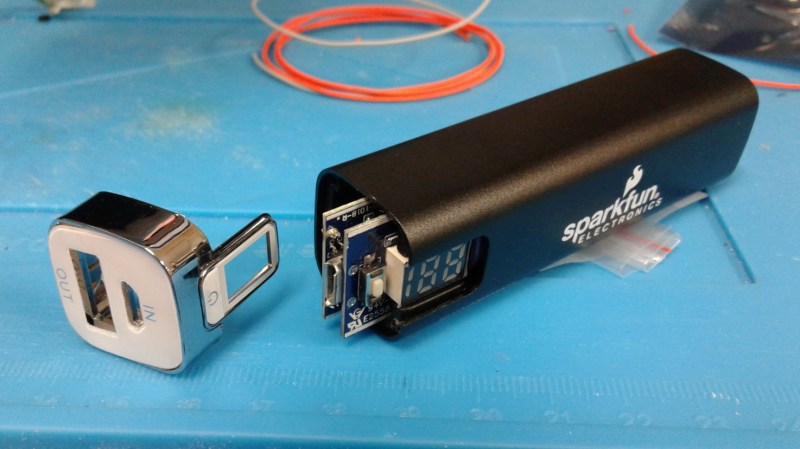For devices that are destined for momentary and infrequent use as well as battery power, some kind of power saving is pretty much a required feature. For example, when [PJ Allen] turned two ESP8266-based NodeMCU development boards into a replacement wireless remote garage door opener, a handy USB power bank ended up serving as a bit of a cheat when migrating the remote away from the workbench. Instead of moving the board from USB to battery power and implementing some kind of sleep mode or auto-off, [PJ Allen] simply plugged in a USB power bank and let it do all the work.

This is how the feature works: some USB power banks turn themselves off unless they detect a meaningful current draw. That means that if the power bank is charging a phone, it stays on, but if it’s only lighting up a few LEDs, it’ll turn itself off. This feature can be a frustrating one, but [PJ Allen] realized that it could actually be useful for a device like his garage door remote. Turning on the power bank delivers 5 V to the NodeMCU board and allows it to work, but after about fifteen seconds, the power bank turns itself off. Sure, strapping a power bank to the remote makes the whole thing bigger than it needs to be, but it’s a pretty clever use of the minimum load as an effortless auto-off feature.
The NodeMCU boards in [PJ Allen]’s DIY remote use ESP-NOW for their wireless communications, a nifty connectionless protocol from Espressif that we’ve seen used in other projects as well, such as this ESP32-based walkie-talkie.















I have a 1100 lumin work light I use as a bike headlight. It has a USB port for charging, great. But it shuts off after running a LED taillight for a minute. Urgh! How much power load do I have to waste to keep the light on?
Not much if it’s intermittent. See, e.g. https://youtu.be/lOL3ic8msas
It generally doesn’t have to be a DC current — small pulses (few ms) every 5 s should be sufficient.
Thanks jp314! This is useful info. Do you have any idea what the minimum current draw required for the pulses should be?
I see a problem where a 555 really *IS* the best solution….
i just went oldskool and popped a small (5AH) Sealed Lead Acid on my bike lights; when compared to a pre-made or roll-your-own Lithium pack, the balance was a no-brainer
The premade lithium packs use a custom (12.6v) charger
VS
SLA uses any car charger
BMS safeties at 5A draw (my horn made it shut down)
VS
SLA gives no fucks
I did not want to go through the whole song-and-dance of spinning up a battery pack from cells (this was before I had a 3D printer)
VS
SLA 5AH, ‘home alarm system’ style from Big Box Hardware, $16 no-fuss
yes, the lead acid weighs more, but that’s peanuts compared to the bike engine’s own weight
I was accidentally reminded of this feature of power banks a couple of weeks ago. I have a remote ESP32 that monitors temperature. I have it running on a 6V lantern battery. The device sleeps most of the time, waking up every 20 minutes to report sensor readings. When that battery died and I was thinking about replacing it, I had the bright idea of using a USB power bank. I have a bunch of them here.
I plugged in the ESP32, saw that it was sending readings and then going to sleep, and then I put it in the remote location. Updates stopped. Repeat that 2 or 3 times with different USB power packs and other ideas. About then I remembered about this automatic shutdown feature. Doh! All of my USB power packs seem to have that feature.
The ESP32 is back to running on a 6V lantern battery (actually, 2 that I wired in parallel for longer life).
Very cool that someone was clever enough to exploit this feature for this interesting use.
I have the same problem with my garage door opener. Is there a possibility to get the source code?
Tanks
Stephan
I am 100% annoyed with such auto-power-off “feature” of said power banks; The (relatively) low power consumption of an Arduino project (for example) makes it turn off every freaking time. not good
My implementation of a Garage Door remote: http://wizworks.net/garage-door/
Nifty solution. Alternatively, one can use a small battery and a couple of transistors to have a real auto-off: https://youtu.be/iCpbvQw01Iw